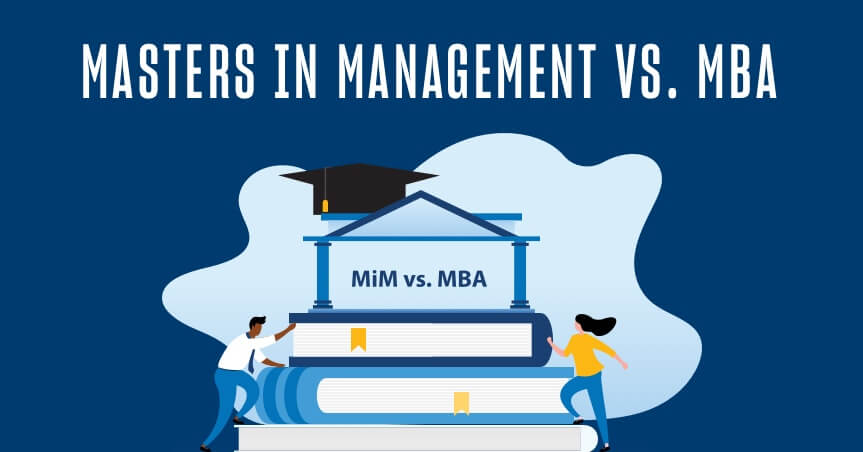If you’re interested in developing your managerial skills through an advanced degree program, you’ve likely considered pursuing the most popular graduate degree — a Master’s in Business Administration (MBA). However, there are several other postgraduate opportunities to develop your managerial skills, options that may be better aligned with your unique background, goals and interests.
Whether you’re hoping to advance to a leadership position within a business or thinking of creating your own startup, consider looking into what a Masters in Management offers in comparison to a more traditional MBA — as well as your other entrepreneurial alternatives.
What Is a Masters in Management?
The Masters in Management (MiM) degree, also known as the Master of Science in Management (MSM), was first introduced in French business schools in the 19th century. As an advanced degree, the MS in Management was intended to provide foundational business knowledge and leadership skills compared to the more demanding and specialized knowledge of MBA programs. It offers a more theoretical approach to business practices for those coming from technical or humanities backgrounds.
While MBA programs typically prefer that applicants have a few years of professional experience, the MiM is intended for those who don’t yet have extensive work experience and are directly out of school. Some universities even offer a combined bachelor’s and MiM degree program, which can be completed within five years. For those who wish to transition into the business field and then advance to a leadership position, there’s also the option to first earn an MiM degree and then supplement with an MBA for a specialized field.
What Is an MBA?
The Master’s of Business Administration is an internationally recognized advanced degree designed to help professionals develop the skills required for careers in business and management. Considered a terminal degree, the MBA is the highest business degree that students typically earn and is valued for its versatility and its perceived advantages. MBAs are the degree of choice for those looking to advance a corporate career, those looking to transition into a business-related career and those who want to develop their skills as entrepreneurs. MBA.com reports that the average starting salary for MBA graduates in 2021 was between 22% and 40% higher than those with bachelor’s degrees.
MBA courses are intended to teach the essentials of business with courses relating to statistics, marketing, economics, communications, finance and management. While most programs will share core courses, some will offer specializations in different areas, including accounting, healthcare management or analytics intelligence. MBA programs are offered as either full-time MBAs, which take about two years to complete, or shorter part-time MBA and executive MBA programs.
See a full comparison of MBA and executive MBA programs in our blog post MBA vs EMBA: 8 Key Differences.
MiM vs. MBA: Who Are These Programs For?
The students who attend MS in management programs tend to be immediately out of bachelor’s programs. Thus, they tend to be younger (early 20s) and less experienced than those who are admitted to MBA programs. MiM programs are good fits for business students who:
- Have recently or will soon graduate from a business-focused bachelor’s program
- Have no professional or work experience
- Will be applying for entry-level positions
- Want to earn their degree within one year
By comparison, MBA programs are positioned for those who have more experience within their fields, so applicants tend to be in their late 20s to early 30s. Executive MBA students tend to be even older and more experienced, usually 30–40-year-olds who have been in management positions. As a result, MBA programs are generally favored by students who:
- Have at least of year of professional work experience
- Plan to apply for higher-level management positions
- Can dedicate to a full-time program for two years, or
- Will split their work schedule with a part-time or executive MBA program
As MiM programs originated in Europe, the degree tends to be more widely known and popular among students in the EU. However, the Masters in Management degree is gaining in popularity vs. the MBA, as the Graduate Management Admissions Council’s (GMAC) 2021 Application Trends Survey showed that nearly half (49%) of MiM programs continued to show growth in applications. It’s a notable statistic when compared to the 41% growth across all MBA programs in 2021, which was at a five year low.
MiM vs. MBA: Admission and Application Requirements
MBA programs require that applicants possess an undergraduate degree within a business discipline. While many programs won’t require work experience, they will heavily favor applicants who can demonstrate at least a few years of business-related work experience. Most MBA programs will also require the submission of Graduate Management Admission Test (GMAT) results.
The main draw of the Master’s in Management degree is that it does not require any prior work experience from its applicants. MiM programs also won’t necessarily require applicants to have a business-related bachelor’s degree and may accept applicants who’ve earned degrees in business-adjacent fields such as communication, accounting or marketing. Depending on the particular program, either GMAT or GRE scores will need to be submitted.
In addition, both the MS in management and MBA programs are likely to require the submission of:
- Resume or Curriculum Vitae
- Personal statement
- Letters of recommendation
MiM vs. MBA: Coursework and Classes
You can expect MiM coursework to cover general and introductory business management. As the degree is designed for those who intend to start a career, courses will tend to focus more on business theory and fundamental knowledge. Coursework will involve the utilization of statistics to teach theoretical concepts and principles through classroom instruction and a review of case studies. The intent is to enable students to develop their management, communication and critical thinking skills.
MBAs assume that students have a higher base level of knowledge, and so coursework will be more about developing problem-solving skills by encouraging students to find innovative solutions for a diverse range of business issues. While MBAs will also examine real-world case studies, they’re more focused on asking students to apply key concepts and find innovative solutions to problems. They also may expect students to bring their own “real world” experience to bear. The intent is to develop skills and knowledge around a particular concentration, often finance, strategy, marketing or operations.
The completion time will vary depending on the program, though most MiM programs can be completed within a year, while a full time MBA program will require twice the amount of credit hours and can take anywhere from two to three years to complete. Part-time MBA programs will take longer, anywhere from three up to six years. Accelerated or online MBA programs are often designed to be completed in about one year.
MiM vs. MBA: Tuition
The exact cost of each program will vary by institution and country. You can expect most MiM programs within the U.S to cost an average of $50,000. In general, you can expect full-time MBA programs to be two to three times more expensive than MiM programs, ranging from $100,000–$200,000 for tuition and other costs. Part time MBA and EMBA programs will tend to cost less than full-time MBA programs, ranging from $55,000–$100,000.
MiM vs. MBA: Salary and Career Outlook
In general, a graduate degree will boost both your chances of being hired and your earning potential. GMAC’s 2022 Corporate Recruiter’s survey reports that a majority (61%) of corporate recruiters see those with graduate degrees as more desirable hires compared to those with only “micro-credentials” — which consist of bachelor’s degrees supplemented with certifications and earned experience.
According to the same survey, the average median starting salary offered to new MBA hires is $115,000 USD, whereas the average median starting salary for new MiM hires in the U.S. is $95,000 USD. MBA graduates can expect to earn more than those from MiM programs both because of their previous work experience and because they tend to be hired in more senior positions.
Most MBAs programs prepare students to enter into leadership roles and provide students with the basis for career acceleration or career change, while MiMs will generally need more work experience. Different regions will also be more open to hiring MiM graduates, with Western European corporate recruiters in particular more likely to hire candidates directly from MiM programs.
Recruiters will favor MiM graduates for roles in human resources or organizational management, while MBA hires will be positioned more for leadership roles in strategy/innovation or general management. See our blog post, 10 Best Jobs for MBA Graduates, for a detailed list of the top positions that MBA graduates are hired for.
Which Degree is Best for Me?
Your choice of program will depend on your level of professional experience and immediate goals.
If you’re graduating with a degree in a technical or humanities field and would like to get into business, and have little to no experience as a professional, then an MiM can teach you important theories and fundamental principles related to the business sector.
Alternatively, if you’ve graduated with a business degree and are interested in moving directly into a management or higher level position, then you should strongly consider the MBA program. If you have at least one year of work experience, then you’re more strongly suited toward an MBA program. You should also consider that MBA programs are a larger commitment, as they cost more and require a greater number of credit hours compared to MiM programs.
However, if you’re looking for an in-depth understanding of fundamental and advanced business models, concepts and practices and are more interested in starting your own business or startup, then you have a third option to consider. The University of San Diego’s Master of Innovation in Technology and Entrepreneurship is designed for those whose focus is on areas related to tech startup opportunities, such as identifying innovation opportunities and securing venture capital.
If you’re an aspiring professional interested in joining a tech startup, seeking to innovate new initiatives as an intrapreneur or in starting a career as an entrepreneur in a technology-related field, then we invite you to explore USD’s MITE degree program and accelerate your career.
Frequently Asked Questions
Are you an aspiring startup entrepreneur or tech executive? Here’s why you need to know about connectivity. Get the free eBook.
.




